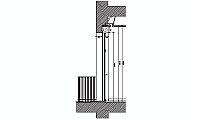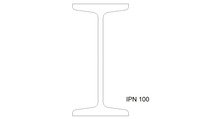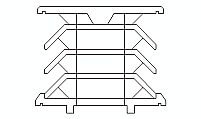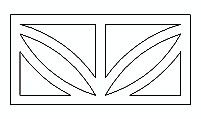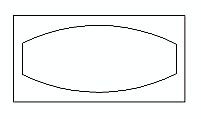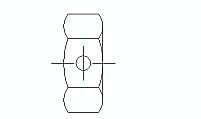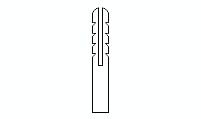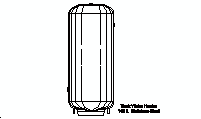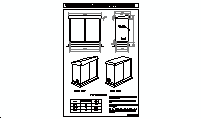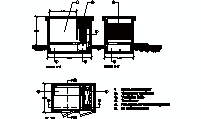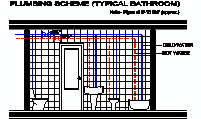CAD Blocks categories
 3D models
3D models home furniture
home furniture sanitary ware - bathrooms
sanitary ware - bathrooms professional equipment
professional equipment doors and windows
doors and windows people and animals
people and animals plants and trees
plants and trees vehicles - transports
vehicles - transports architectural details
architectural details mechanical - electrical
mechanical - electrical urban planning - civil works
urban planning - civil works safety health construction
safety health construction accessible design
accessible design drawing sheet
drawing sheet signals
signals construction machinery
construction machinery accessories and objects
accessories and objects maps and street maps
maps and street maps
Intricate Decorative Wrought Iron Railing Design

size: 15 kb
category: architectural details
related categories:
description: decorative wrought iron railing with intricate floral details on each baluster, pointed spear-like ends, and hollow circular connections, topped with parallel handrails.
file extension: .dwg CAD - AutoCAD software
Detailed CAD Block of Decorative Wrought Iron Railing
Detailed Description of the Decorative Wrought Iron Railing
This decorative wrought iron railing showcases a design that combines elegance and security. The lower section features pointed spear-like ends resembling sharp blades or leaves, which are connected by hollow circular elements for a seamless appearance. The balusters are adorned with two intricate floral motifs positioned along the shaft, adding an organic touch to the design. The upper section is finished with two parallel thin bands acting as a sturdy and minimalistic handrail, ensuring both functionality and style.
Alternative designs may focus on simpler geometric shapes or more ornate patterns with denser detailing. This railing, with its combination of pointed elements and floral decorations, strikes a balance between aesthetic appeal and robust construction, making it suitable for a wide range of architectural styles.
Common Dimensions of Decorative Wrought Iron Railings
Typical dimensions for decorative wrought iron railings include a height of 36 inches (91.44 cm) for standard balcony or staircase applications. The pointed spear-like ends often extend an additional 4 inches (10.16 cm) below the main structure, emphasizing the design's elegance and function. The floral motifs are typically positioned around the middle of the baluster shaft, which measures approximately 1 inch (2.54 cm) in diameter.
The dual handrails at the top measure 0.5 inches (1.27 cm) in thickness each, ensuring a sleek yet durable finish. The circular hollow connectors have a diameter of 2 inches (5.08 cm), contributing to the overall balance and proportionality of the design.
Installation and Construction Tips
- How is this railing installed?
- The railing is typically secured to the ground or steps using metal brackets that are welded or bolted into place. Precision is crucial during installation to ensure uniform spacing between balusters and alignment with the overall architectural structure. Proper tools such as drills, levels, and welding equipment should be used for accurate placement and secure attachment.
- What materials are commonly used?
- High-quality wrought iron is the preferred material for its durability and resistance to wear. It is often treated with a rust-resistant coating to enhance its longevity in outdoor settings. Stainless steel may also be used for areas requiring higher corrosion resistance, while aluminum offers a lightweight alternative for easier handling during installation.
- Can it be customized?
- Yes, the railing design can be customized to include additional decorative elements, alternative handrail styles, or modifications to the floral and pointed motifs. Powder coating or hand-painted finishes can also be applied to match specific aesthetic themes. Custom dimensions and patterns can be created to fit unique architectural requirements, ensuring harmony with the surrounding space.
- How do you maintain this railing?
- Regular cleaning with a damp cloth and mild detergent helps maintain the railing's appearance. Applying a rust-resistant coating annually, especially for outdoor railings, will protect against environmental wear. Inspecting for loose bolts, chips in the finish, or corrosion spots allows for timely repairs, prolonging the structure's life and safety.
- Can it be paired with other materials?
- Yes, this railing pairs beautifully with stone or brick bases for a classic look, or with glass panels for a modern touch. The versatility of wrought iron allows it to complement wood elements, creating a warm and rustic appearance. These combinations can be tailored to fit both traditional and contemporary architectural themes.
Advantages of Decorative Wrought Iron Railings
Decorative wrought iron railings provide an unmatched combination of strength and aesthetic appeal. Their intricate designs add character to staircases, balconies, and terraces while maintaining structural integrity. The pointed spear-like ends and floral motifs make these railings a statement piece in any architectural project.
Compared to plain metal or wooden railings, wrought iron offers greater durability and requires less maintenance over time. Its versatility in design ensures compatibility with a range of architectural styles, making it a timeless choice for both traditional and modern spaces.
History and Evolution of Wrought Iron Railings
Wrought iron railings have been a staple in architecture since the 16th century, originally crafted for their strength and ability to be shaped into intricate patterns. Over time, the designs evolved to include more elaborate motifs, reflecting the artistic trends of different eras such as the Baroque and Victorian periods.
Today, wrought iron railings continue to be valued for their durability and beauty. Modern manufacturing techniques allow for even more customization, incorporating traditional elements like spearheads and floral patterns alongside contemporary geometric designs. This adaptability ensures their continued relevance in architectural design worldwide.



